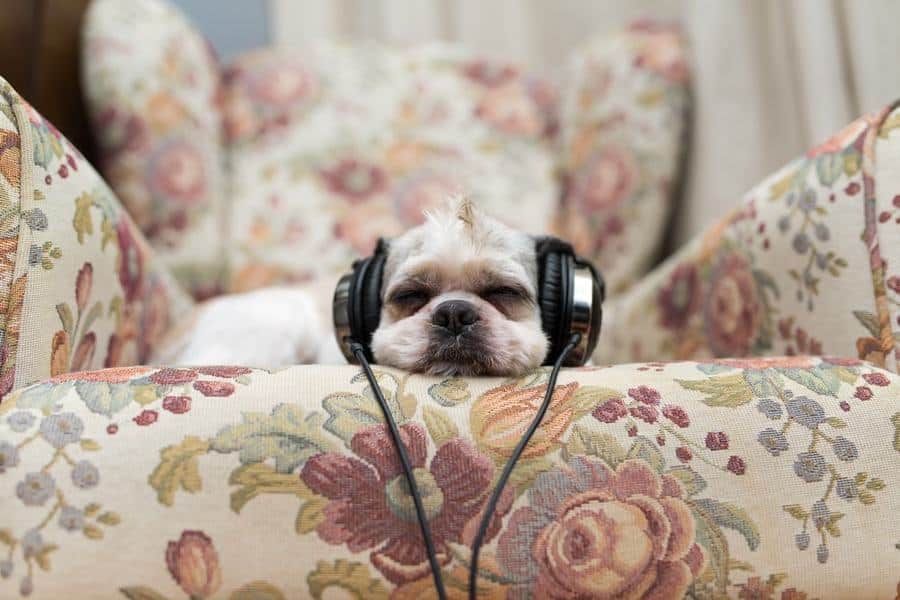“This post contains affiliate links, and I will be compensated if you make a purchase after clicking on my links.”
Anxiety is common in dogs. When thunderstorms or fireworks are going on outside, your dog has little understanding of what is causing these loud noises. This causes them to feel vulnerable and becomes anxious. As a pet parent who loves your canine, you’re probably looking for easy and affordable ways to reduce this anxiety in your dog. Music is a great tool to introduce to your pet when loud noises are going on, or when a large family gathering with a lot of new people is taking place.

by Natalie Wilson
If you’re looking to learn more about how music can reduce anxiety in dogs, you’ve come the right place. Below are five different ways you can improve your dog’s life through the power of music.
1. By emphasizing certain frequencies
Just as how humans prefer certain frequencies, dogs are more receptive to certain frequencies in their music as well. If you consider music that is popular with humans, many of the frequencies fall within our natural vocal range. With dogs, the preferred frequency is around 396 Hz. To give you an idea of the pitch, the lowest note on the piano is about 27.5 Hz. 396 Hz is the first G above middle C on the piano and is therefore in a comfortable hearing range for humans and dogs. Michael Tyrrell discovered this preferred frequency through extensive research and has now created Wholetones, a great musical resource for humans and their dogs.

2. By using a consistent rhythm
Music with consistent rhythms will also have the ability to reduce anxiety in dogs. Dogs have been found to dislike rhythms that are obscure or inconsistent in nature. This is why a steady beat in the key of G major might resonate best with your dog. Dogs have been found to enjoy reggae music, which typically has a consistent rhythm that accents beat 2 and 4 in a 4/4 bar. Next time you’re playing music for your dog, try turning on some Bob Marley and take note of their reaction! You might find you have a serious reggae fan on your hands.
3. By using smooth, long notes
The types of notes played will also affect your dog’s anxiety levels. In a study that investigated dog’s reactions to Metallica’s music compared to the music of Beethoven and Vivaldi, researchers found the heavy metal music, which often uses detached notes, induced more anxiety in the dogs, while the classical styles of music had a calming effect. It’s important to note that just because the dogs reacted better to the classical music in this study, doesn’t mean dogs will enjoy all classical music.
Many classical pieces will contain choppy, detached notes which won’t appeal to your dog’s tastes. Before you press play on your speakers, make sure you prioritize smoothness over the genre.
4. By using soft instruments
Remember that your dog has much more sophisticated hearing abilities than any human. This is one reason our ancestor domesticated dogs: they used their hearing abilities to hunt for food. Your dog’s hearing abilities may mean that instruments the human ear can handle well may be too loud and overwhelming for a canine.
For example, a trumpet is a loud instrument even for the human ear. This may mean that songs played on a trumpet may cause anxiety in your pet, rather than reduce it. Imagine feeling anxious after hearing the loud, intimidating sounds of a thunderstorm. If someone came and turned a speaker up to its full volume, your anxiety would likely increase, regardless of the sound. Guitar is a great instrument for dogs because of its ability to be played softly. To learn more about the best fingerstyle guitars, take a look at this article.
5. By incorporating natural sounds
Remember that what is “natural” is subjective. This is why the creation of species-specific music has been so helpful in reducing anxiety in animals. Species-specific music has become very popular since Music for Cats set new standards for composers. Every song we listen to has been designed for human ears, and the music, therefore, contains sounds that humans enjoy. When finding music that will reduce anxiety in your dog, it’s important to consider what their species will find comforting. This might involve sounds heard while on walks, such as crickets, birds, and even human voices.
Hopefully, you find these tips for reducing anxiety in your dog useful! Remember that your dog’s preferences will be unique to them, so stay open to some musical experimentation. Dogs tend to like natural sounds around 396 Hz, consistent rhythms, and smooth, soft notes. If you’re looking for some songs to get you started, check out this playlist. Enjoy getting to know your dog’s musical side!
About the author:

Hi there!
I’m Natalie.
I work as a session guitarist, and guitar teacher, and I would like to use my music blog as a personal outlet to share my six-string knowledge with the world.
Follow me: http://twitter.com/MusicalAdvisors
Contact me : [email protected]



























Thanks for posting about doggie anxiety. We are passionate about keeping our pets healthy too. Our poop scoop service offers peace of mind to our pets with a clean place “to go” and more time to their owners- making for healthier pets all together! Thanks for this great content! Keep it coming.
[…] and studies show that certain music styles help dogs feel anxiety relief, too! According to The Dogington Post, when selecting music to relieve your dog’s anxiety, you should prioritize songs with smooth, […]